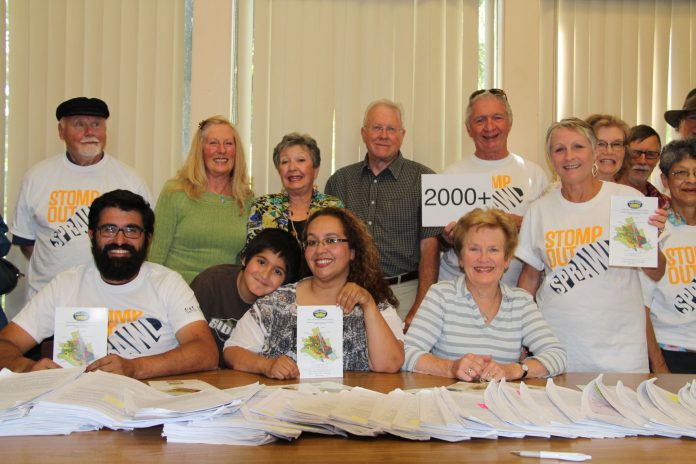Wearing t-shirts with “Stomp out Sprawl” emblazoned across their chests and carrying two large file boxes filled with more than 3,500 signed petitions in support of an urban growth boundary (UGB) for Gilroy, the folks of Gilroy Growing Smarter (GGS) were in a celebratory mood on Monday at City Hall.
“This ought to send a message, shouldn’t it?” said volunteer signature gatherer Jim Bradford as the stacks of completed petitions were spread out across the conference room table in council chambers.
Over a period of six weeks, 43 unpaid volunteers collected 3,558 signatures in support of the UGB initiative, which would place a boundary around Gilroy in an effort to limit sprawl and concentrate future development in the downtown core.
The group needed 1,923 signatures, 10 percent of Gilroy’s registered voters, for the initiative to qualify for the November ballot.
“We wanted to make sure we hit our target,” said Sandie Silva, of the group’s signature gathering effort. “We almost doubled the number we needed to have.”
Gilroy city clerk, Shawna Freels, took possession of the completed petitions at 3 p.m. on Monday.
After she validates each petition, they will go to the county registrar of voters for signature verification.
For a signature to qualify, the person needs to be a registered voter within the city of Gilroy.
“I was shocked how many people did not like the idea of sprawl,” said Barbara Ordons, a volunteer who collected 150 signatures.
Volunteers obtained signatures outside local supermarkets, in cafes, at sporting events and by going door-to-door.
One of the group’s founding members, former Gilroy City Councilmember Connie Rogers, said it was a bit “intimidating” explaining the initiative to strangers in 30 seconds or less, but for the most part, people were very enthusiastic about the UGB proposal, which would require voter approval for large developments proposed for outside the boundary.
“Very few declined to sign and a lot of people thanked us for doing this,” she said.
Volunteer Bruce Harper echoed the sentiment.
“People came up to me with two different attitudes: anger over what is happening to the countryside and relief that something was happening about it,” he said.
The county registrar of voters has 30 days to certify the signatures.
If the signatures are correct and the group meets its target, the City Council can either adopt the UGB initiative as an ordinance or place the measure on the November ballot for Gilroy voters to decide.
If passed in November, “the UGB would provide enough land for Gilroy to grow from its center outwards at historical rates for 25 years, while establishing a surrounding belt of open space and agricultural land free of most kinds of development,” according to Gilroy Growing Smarter.
The initiative provides exceptions for certain kinds of development, including schools, water projects, affordable housing and industrial projects.
The City Council has approved up to $150,000 for an impartial analysis of the potential impacts an urban growth boundary would have on the city.
The Gilroy Chamber of Commerce and the Gilroy Economic Development Corporation have publicly come out against the UGB initiative.
For information on the UGB initiative, go to: www.gilroygrowingsmarter.org.













